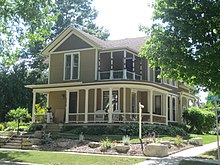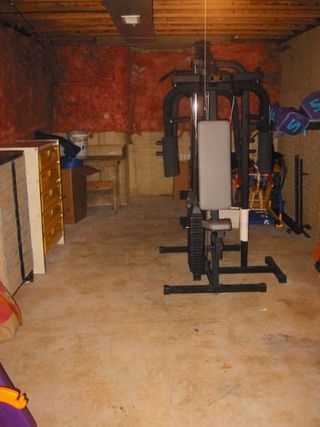

Housing in Wisconsin is mainly based on detached homes. Additional kinds of housing include multiple-unit buildings, typically owned by a corporation or individual. Several home styles have been popular, including ranch and split-level houses. [1]


Housing in Wisconsin is mainly based on detached homes. Additional kinds of housing include multiple-unit buildings, typically owned by a corporation or individual. Several home styles have been popular, including ranch and split-level houses. [1]
During the 1800s, people started to settle in Wisconsin, bringing their home styles with them. Important styles in Wisconsin during this time include colonial and Greek revival. [1] During the 1900s, important cities such as Madison and Milwaukee started to grow rapidly. During this time, several public housing developments were built. As of January 2019, there were 4,538 homeless individuals living in Wisconsin. [2]
Central heating is most commonly found in Wisconsin homes. Homes typically include a gas furnace, and in older homes, a wood furnace. [3] In most modern homes, HVAC is installed, with separate heating and cooling units. In older homes, usually only a furnace is installed, with a window unit air conditioner instead of a standard air conditioning unit. All residences are required to have insulation installed. [4]
Gas-powered dryers and stoves are typically found in older homes, with more modern homes using electrically powered equivalents.

Heating, ventilation, and air conditioning (HVAC) is the use of various technologies to control the temperature, humidity, and purity of the air in an enclosed space. Its goal is to provide thermal comfort and acceptable indoor air quality. HVAC system design is a subdiscipline of mechanical engineering, based on the principles of thermodynamics, fluid mechanics, and heat transfer. "Refrigeration" is sometimes added to the field's abbreviation as HVAC&R or HVACR, or "ventilation" is dropped, as in HACR.

A furnace, referred to as a heater or boiler in British English, is an appliance used to generate heat for all or part of a building. Furnaces are mostly used as a major component of a central heating system. Furnaces are permanently installed to provide heat to an interior space through intermediary fluid movement, which may be air, steam, or hot water. Heating appliances that use steam or hot water as the fluid are normally referred to as a residential steam boilers or residential hot water boilers. The most common fuel source for modern furnaces in North America and much of Europe is natural gas; other common fuel sources include LPG, fuel oil, wood and in rare cases coal. In some areas electrical resistance heating is used, especially where the cost of electricity is low or the primary purpose is for air conditioning. Modern high-efficiency furnaces can be up to 98% efficient and operate without a chimney, with a typical gas furnace being about 80% efficient. Waste gas and heat are mechanically ventilated through either metal flue pipes or polyvinyl chloride (PVC) pipes that can be vented through the side or roof of the structure. Fuel efficiency in a gas furnace is measured in AFUE.
A chimney is an architectural ventilation structure made of masonry, clay or metal that isolates hot toxic exhaust gases or smoke produced by a boiler, stove, furnace, incinerator, or fireplace from human living areas. Chimneys are typically vertical, or as near as possible to vertical, to ensure that the gases flow smoothly, drawing air into the combustion in what is known as the stack, or chimney effect. The space inside a chimney is called the flue. Chimneys are adjacent to large industrial refineries, fossil fuel combustion facilities or part of buildings, steam locomotives and ships.

A thermostat is a regulating device component which senses the temperature of a physical system and performs actions so that the system's temperature is maintained near a desired setpoint.

Water heating is a heat transfer process that uses an energy source to heat water above its initial temperature. Typical domestic uses of hot water include cooking, cleaning, bathing, and space heating. In industry, hot water and water heated to steam have many uses.

A basement or cellar is one or more floors of a building that are completely or partly below the ground floor. Especially in residential buildings, it often is used as a utility space for a building, where such items as the furnace, water heater, breaker panel or fuse box, car park, and air-conditioning system are located; so also are amenities such as the electrical system and cable television distribution point. In cities with high property prices, such as London, basements are often fitted out to a high standard and used as living space.

A central heating system provides warmth to a number of spaces within a building from one main source of heat. It is a component of heating, ventilation, and air conditioning systems, which can both cool and warm interior spaces.

Johnson Controls International plc is an American, Irish-domiciled multinational conglomerate headquartered in Cork, Ireland, that produces fire, HVAC, and security equipment for buildings. As of mid-2019, it employed 105,000 people in around 2,000 locations across six continents. In 2017 it was listed as 389th in the Fortune Global 500. It became ineligible for the Fortune 500 in subsequent years since it relocated its headquarters outside the U.S.

Housing in Japan includes modern and traditional styles. Two patterns of residences are predominant in contemporary Japan: the single-family detached house and the multiple-unit building, either owned by an individual or corporation and rented as apartments to tenants, or owned by occupants. Additional kinds of housing, especially for unmarried people, include boarding houses, dormitories, and barracks.

Superinsulation is an approach to building design, construction, and retrofitting that dramatically reduces heat loss by using much higher insulation levels and airtightness than average. Superinsulation is one of the ancestors of the passive house approach.

Electric heating is a process in which electrical energy is converted directly to heat energy. Common applications include space heating, cooking, water heating and industrial processes. An electric heater is an electrical device that converts an electric current into heat. The heating element inside every electric heater is an electrical resistor, and works on the principle of Joule heating: an electric current passing through a resistor will convert that electrical energy into heat energy. Most modern electric heating devices use nichrome wire as the active element; the heating element, depicted on the right, uses nichrome wire supported by ceramic insulators.

A heating system is a mechanism for maintaining temperatures at an acceptable level; by using thermal energy within a home, office, or other dwelling. Typically, these systems are a crucial part of an HVAC system. A heating system can be categorized into central heating system or distributed systems, depending on their design and method of heat distribution.
Renewable heat is an application of renewable energy referring to the generation of heat from renewable sources; for example, feeding radiators with water warmed by focused solar radiation rather than by a fossil fuel boiler. Renewable heat technologies include renewable biofuels, solar heating, geothermal heating, heat pumps and heat exchangers. Insulation is almost always an important factor in how renewable heating is implemented.

An air source heat pump (ASHP) is a heat pump that can absorb heat from air outside a building and release it inside; it uses the same vapor-compression refrigeration process and much the same equipment as an air conditioner, but in the opposite direction. ASHPs are the most common type of heat pump and, usually being smaller, tend to be used to heat individual houses or flats rather than blocks, districts or industrial processes.

An oil burner is a heating device which burns #1, #2 and #6 heating oils, diesel fuel or other similar fuels. In the United States, ultra low sulfur #2 diesel is the common fuel used. It is dyed red to show that it is road-tax exempt. In most markets of the United States, heating oil is the same specification of fuel as on-road un-dyed diesel.

A ground source heat pump is a heating/cooling system for buildings that use a type of heat pump to transfer heat to or from the ground, taking advantage of the relative constancy of temperatures of the earth through the seasons. Ground-source heat pumps (GSHPs) – or geothermal heat pumps (GHP), as they are commonly termed in North America – are among the most energy-efficient technologies for providing HVAC and water heating, using far less energy than can be achieved by burning a fuel in a boiler/furnace or by use of resistive electric heaters.

A packaged terminal air conditioner (PTAC) is a type of self-contained heating and air conditioning system intended to be mounted through a wall. The first practical semi-portable air conditioning unit invented by engineers at Chrysler Motors. It entered the market in 1935, and was designed to fit under a window like many modern PTACs.
HVAC is a major sub discipline of mechanical engineering. The goal of HVAC design is to balance indoor environmental comfort with other factors such as installation cost, ease of maintenance, and energy efficiency. The discipline of HVAC includes a large number of specialized terms and acronyms, many of which are summarized in this glossary.
Zero-carbon housing is housing that does not emit greenhouse gasses (GHGs) into the atmosphere, either directly, or indirectly due to consumption electricity produced using fossil fuels. Most commonly zero-carbon housing is taken to mean zero emissions of carbon dioxide, which is the main climate pollutant from homes, although fugitive methane may also be emitted from natural gas pipes and appliances.

Housing in Florida consists of apartments, condominiums, hotels, retirement communities, and houses. Common types of housing in the state include Cracker style homes, Ranch-style homes, Caribbean style homes, and Condominiums with styles including Spanish Colonial Revival architecture, Victorian architecture, Mediterranean Revival architecture, Art Deco, Modern architecture, and Pueblo Revival architecture.